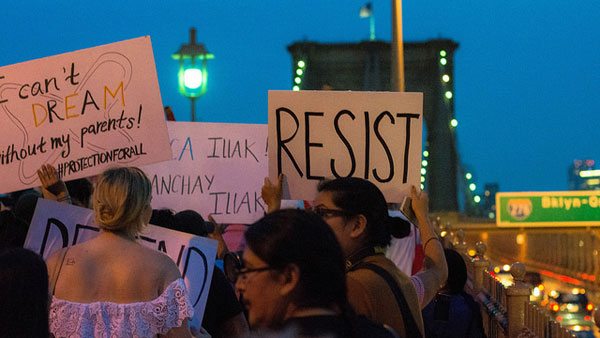
September 6, 2017; The Conversation
Early this week Trump announced plans to rescind Deferred Action for Childhood Arrivals (DACA), President Obama’s immigration initiative to protect undocumented young people brought to the U.S. by their parents, and gave Congress until March 5, 2018 to act on the issue. As NPQ’s Jim Schaffer wrote, protests erupted in major cities, immigrants’ rights activists promised to fight, and major for-profits objected. Trump quickly pivoted from recommending that Dreamers begin to prepare for self-deportation to assuring them they had nothing to worry about. What is really going on?
Slate did a little digging with U.S. Citizenship and Immigration Services, the Department of Homeland Security office responsible for implementation, to find out what this means for Dreamers and created its own FAQ. To start, Dreamers must follow rather dense guidelines to preserve their status through the next six months. No new DACA applications will be approved after September 5th. Renewal requests for DACA status expiring by March 5th will be processed through October 5th. Dreamers whose DACA status expires after March 5th cannot apply for renewal. Loss of DACA status means loss of work permit, loss of in-state tuition rates, possible discharge from the military, loss of out-of-country travel eligibility, and, of course, eligibility for deportation.
According to Wayne Cornelius of The Conversation, DACA is widely viewed as Obama’s most successful immigration policy—it is both moral and economically beneficial for the U.S. “A 2017 survey of more than 3,000 DACA recipients found that 97 percent are currently employed or enrolled in school.” DACA allowed recipients to access higher-paying jobs, which “made college more affordable and increased their tax contributions.” It also allowed young immigrants to experience relative security and normalcy, being able to obtain a driver’s license, purchase property or a vehicle, and travel within the U.S.
Sign up for our free newsletters
Subscribe to NPQ's newsletters to have our top stories delivered directly to your inbox.
By signing up, you agree to our privacy policy and terms of use, and to receive messages from NPQ and our partners.
There were some things that didn’t work so well. Employers were less willing to invest in training DACA recipients, whose work permits have to be renewed every two years. DACA recipients are ineligible for federal financial aid, which severely limits their ability to attend four-year academic institutions. They are also ineligible for coverage under the Affordable Care Act, and cannot not travel outside the U.S. without permission from the government.
Four bills have been introduced in Congress this year to provide protection for young undocumented immigrants. According to Cornelius, one shows promise: the 2017 Dream Act, sponsored by Sen. Richard Durbin (D-IL), Sen. Lindsey Graham (R-SC), and Rep. Lucille Royball-Allard (D-CA). It creates a 13-year path to citizenship which begins with “conditional permanent residency” for those who can meet requirements similar to DACA’s. “It requires applicants to have been admitted to an institution of higher education, have earned a high school diploma or GED certificate, or be enrolled in a secondary school or GED program.” After eight years, they can apply for permanent legal residency “if they had advanced their education, met certain employment standards and committed no serious crime.” After five more years, they could apply for citizenship. Though with permanent legal residency they could apply for their parents to be legally admitted to the U.S., many parents of Dreamers are already here and being granted a waiver for “unlawful presence” in the U.S. is only done in cases of “extreme hardship.” However, Cornelius notes that “legislation resembling the Dream Act has been introduced in Congress eight times since 2001,” and it has failed each time.
The New Yorker’s Jelani Cobb points out that the Immigration and Nationality Act of 1965 was designed to eliminate the racial quotas set by the Immigration Act of 1924, which had been created to stem the tide of immigration of the time and was praised by Hitler for refusing immigration of certain races and helping to preserve “racial purity.” Cobb asserts that “this is the world that Trump seems to be attempting to resurrect.” What may be different this time is that, while in the 1920s there was a resurgence of the Ku Klux Klan “engendering and exploiting fear…[of] ‘degenerative’ forces…destroying the American way of life,” polls today show that “nearly eight out of 10 Americans—including more than two-thirds of Republicans—support granting citizenship or legal permanent residency to Dreamers.”—Cyndi Suarez













